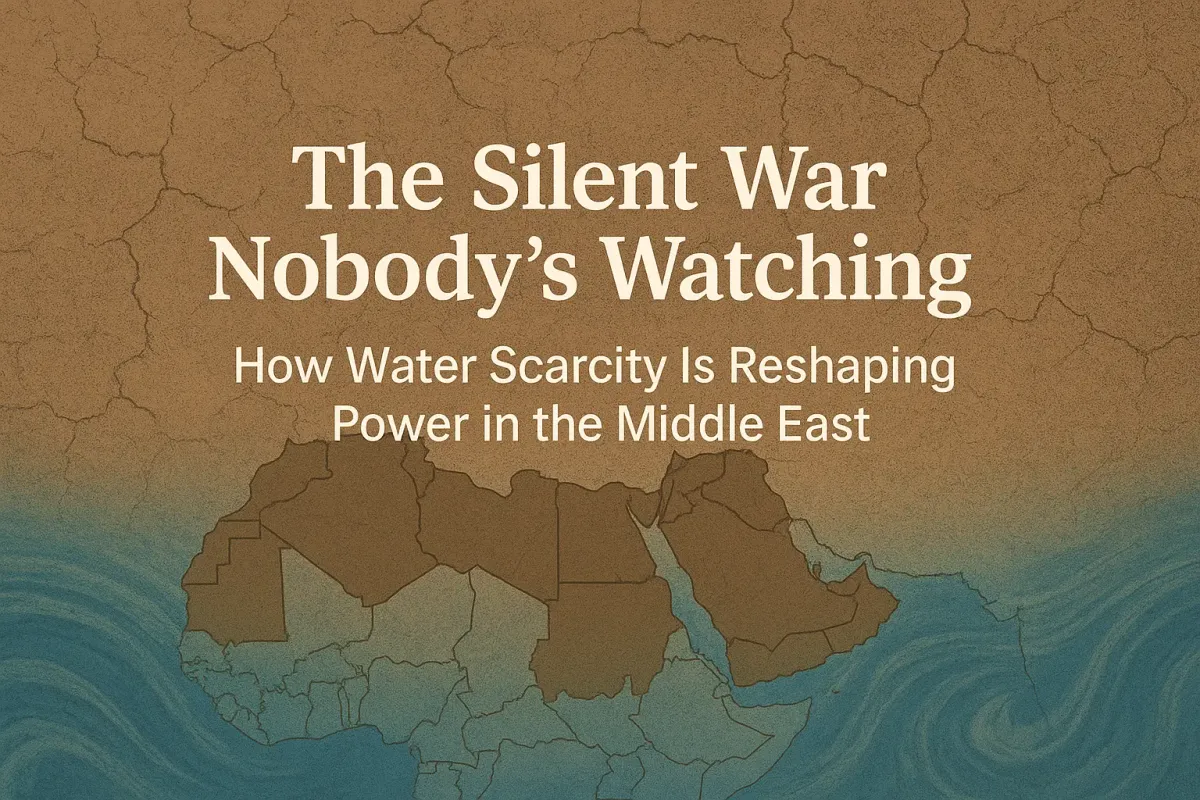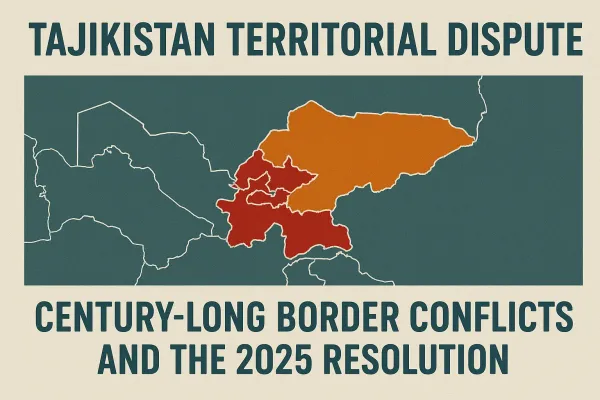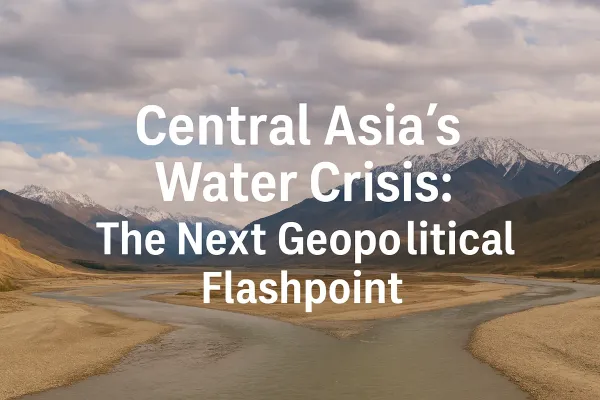Water Scarcity in the Middle East: The Silent Crisis Reshaping Power and Politics (2025 Update)
In 2025, the Middle East faces an escalating water crisis reshaping power and stability. Iran’s drought sparks protests as Gulf states depend on fragile desalination plants. From draining aquifers to rising salinity, water scarcity now threatens the region’s survival.

Everyone’s focused on Trump’s tariffs and Taiwan tensions. Meanwhile, a far more fundamental crisis—the Middle East water crisis—is quietly reshaping the region. It has nothing to do with oil, terrorism, or military alliances. It’s about water scarcity. And unlike those headline-grabbing issues, this one has no diplomatic solution on the horizon.
The Middle East and North Africa (MENA) host 12 of the world’s 17 most water-stressed countries, highlighting the scale of water scarcity in MENA. By mid-2025, the situation has moved from chronic stress to acute crisis. In Iran’s 2025 drought crisis, the government shut down offices, schools, and banks across 11 provinces due to severe water and electricity shortages. Protesters across Iranian cities chanted "Death to the dictator" while demanding their "undeniable right" to water. This wasn't about ideology or freedom—it was about survival.
What makes this geopolitical water conflict different from other global power struggles is its irreversibility. You can negotiate trade deals, redraw borders, or swap prisoners. You can't negotiate with an empty aquifer. ( Sources: World Bank, ABC News )
Gulf Desalination and the Middle East Water Crisis
Gulf states produce roughly 40% of the world’s desalinated seawater, forming the backbone of their water security in the Gulf region. It sounds like a solution until you examine the vulnerability it creates. These countries depend on energy-intensive desalination for up to 90% of their total water needs. Every drop they drink comes from plants that require massive energy inputs, sophisticated infrastructure, and complete political stability.
In June 2025, a false report of an Israeli strike on Iran’s Bushehr nuclear plant sent panic through Gulf capitals—underscoring how fragile Gulf desalination infrastructure really is. Qatar’s prime minister had warned earlier that nuclear contamination would mean “no water, no food, no life,” since the entire region depends on Persian Gulf desalination plants for survival. Gulf governments rushed to reassure citizens that no radiation had been detected, but the episode exposed a strategic weakness in Gulf water dependence that rarely gets discussed: their entire water supply system can be compromised by a single regional conflict.
This isn’t theoretical. Desalination plants in the Gulf are concentrated along coastlines, making them perfect targets in any future war. And the Gulf is hardly a zone of lasting peace. Saudi Arabia’s data centers and industrial zones alone consumed 15 billion liters of water in 2024. As these countries race to build tech infrastructure and diversify away from oil, water scarcity in Gulf states is intensifying under the dual pressure of climate change and economic growth.
The tragic irony is that desalination itself is making the problem worse. Extreme desalination scenarios are increasing subsurface Gulf temperatures by 0.6°C and salinity by 2 grams per kilogram near southern shorelines. They're essentially poisoning the source they depend on.
✨How India Masters Strategic Diversification?
India navigates US-Russia-China tensions through pragmatic balancing—refusing dependence on any single power. The Middle East desperately needs this approach for water security, but national rivalries prevent regional cooperation.
Middle East Water Scarcity and Aquifer Depletion in 2025
While diplomats obsess over the Nile and Euphrates—visible, measurable rivers that generate headlines—underground aquifers in the Middle East are being silently drained in what one analyst called the "tragedy of the commons."
Take the Al-Disi/Al-Saq aquifer shared by Jordan and Saudi Arabia, one of the region’s most stressed fossil aquifers. It's a fossil aquifer, meaning the water accumulated 10,000 to 30,000 years ago and isn't being replenished. Both countries signed an agreement in 2015 to limit extraction, creating protected zones along their border. But the treaty has a fatal flaw: no numerical limits on how much water each side can pump outside those zones.
The result? Both Jordan and Saudi Arabia are racing to drain the aquifer — a striking case of aquifer depletion driving Middle East water scarcity — for agricultural projects that make zero economic sense. They're growing watermelons, tomatoes, and onions—some of the most water-intensive crops imaginable—in the middle of the desert. When Jordan sees Saudi pumping increase, it pumps more too, even when it doesn't need the water. It's pure game theory: if you don't grab it now, the other side will.
Projections indicate current pumping rates will deplete Jordan's portion of the aquifer by mid-century. Saudi Arabia will follow shortly after. And then what? Jordan already faces groundwater level drops exceeding one meter per year in some areas. This isn't a problem for the next generation. It's a crisis unfolding right now.
🌏 The Indo-Pacific's Pragmatic Power Play
Countries across Asia are refusing to pick sides between Washington and Beijing, building flexible partnerships instead. See how this pragmatism reshapes regional power—and why the water-starved Middle East can't adopt the same approach.
→ Read: The Indo-Pacific in 2025: Power, Pragmatism, and the Search for Balance
Iran Water Crisis 2025: How Drought and Protests Are Linked
Iran's situation is even more dire, and it's directly fuelling political instability in ways that could reshape the entire region. The country experienced a nationwide rainfall deficit of around 45% in 2025. Tehran province received just 7 inches of rain. Nationwide dam reserves have fallen to 46% of capacity, with seven major dams below 10% capacity.
More than 40 Iranian cities endure regular water rationing. At least 19 provinces are experiencing water stress. Lake Urmia, once the Middle East's largest saltwater lake, has lost 90% of its volume since the 1970s—an alarming symbol of Iran’s worsening water crisis. Former regime officials have warned that climate trends and water shortages could displace up to 70% of Iran's population—nearly 50 million people.
The protests that erupted in July and August 2025 across cities like Shiraz, Kazerun, and Tehran represent something fundamentally different from previous Iranian protest movements. These weren't ideological demonstrations. They started in industrial and agricultural cities where water and power disruptions directly threaten livelihoods. The working-class and rural populations that form the regime's traditional base are turning against it because the government can't provide the most basic necessity: water.
When protesters chanted "No Gaza, no Lebanon, only the people of Iran," they were making a precise economic argument. Iran's foreign policy adventures drain resources while its own infrastructure collapses. The regime responded with tear gas and mass arrests. But you can't arrest an empty reservoir.
Agriculture consumes over 90% of Iran's water resources. The population has grown more than 50% since 1990, reaching over 80 million. Iran now suffers more than 1,700 heat-related deaths annually—nearly five times the regional average—as temperatures exceed 50°C without adequate infrastructure. Experts warn that without immediate reforms, Iran’s water shortage could become the Middle East’s biggest environmental security threat. Parts of the country are becoming literally uninhabitable.
Why the Middle East Water Crisis Matters More Than Trade Wars
While analysts obsess over China's rare earth export restrictions—which grabbed headlines when Beijing tightened controls in October 2025—the Middle East water crisis and global water scarcity represent far more existential threats to regional stability. Goldman Sachs warned that a 10% disruption in rare-earth-dependent industries could cause $150 billion in economic losses. That's significant, but it's manageable with alternative supply chains and strategic reserves.
Water has no substitute. You can't stockpile it indefinitely. You can't shift supply chains to friendlier countries. And unlike rare earth minerals—where China controls 69% of extraction and 92% of refining but the total market value is relatively small—water touches every single aspect of economic and social life.
Egypt is approaching absolute water scarcity, defined as less than 500 cubic meters per capita annually. The Grand Ethiopian Renaissance Dam dispute has Cairo considering international arbitration and boosting its military presence in the Horn of Africa. Ethiopia views this as aggression. Without perspective shifts in both capitals, armed conflict becomes increasingly likely.
Turkey's dam construction on the Tigris and Euphrates rivers deepens the regional water scarcity crisis, affecting millions of Syrians and Iraqis. These aren't abstract geopolitical tensions. They're conditions that create mass displacement, state collapse, and regional wars.
Future Impact: Migration and Political Instability in the Middle East Water Crisis
The strategic implications of Middle East water scarcity dwarf current geopolitical obsessions. When 70% of Iran's population faces potential displacement due to unliveable conditions, that creates refugee flows that will destabilize the entire region. When Gulf states can't guarantee water supplies because their desalination infrastructure is vulnerable to regional conflicts, their economic diversification plans collapse.
Jordan, Saudi Arabia, Iran, Egypt, Iraq, Syria—these aren't minor players. Their potential destabilization doesn't stay contained. The 2011 Arab Spring was partly triggered by food price spikes linked to water scarcity. That historical precedent should be sobering.
Yet water security remains predominantly a national rather than regional concern. The Gulf Cooperation Council was founded on shared challenges, but water scarcity has been treated as each country's individual problem. That approach is failing spectacularly.
Unlike tariff negotiations or semiconductor supply chains, water crises don't wait for political cycles or diplomatic breakthroughs. Aquifers drain on geological timescales that don't care about election years or summit schedules. By the time this crisis forces itself onto the global agenda, the damage will be irreversible.
Everyone's watching Trump and Xi negotiate over rare earths. Almost nobody's watching the Middle East run out of water. That's a catastrophic misallocation of attention.
Water scarcity is not just an environmental issue—it’s fast becoming the central axis of Middle Eastern geopolitics. The region’s future stability, migration patterns, and even its state borders may ultimately depend not on oil or ideology, but on who controls the last sustainable sources of water.
Related Articles
- The Indo-Pacific in 2025: Power, Pragmatism, and the Search for Balance – Countries across the Indo-Pacific refuse to pick sides in 2025, crafting pragmatic approaches to power politics. See how water scarcity in the Middle East parallels the regional power shifts reshaping Asia's strategic landscape.
- India's Strategic Balancing Act - 2025: Managing Relations with the US, Russia, and China – Explore how India navigates great power competition through strategic flexibility—the same pragmatic approach Middle Eastern states need for water security but haven't yet adopted.
- Tariff Shock 2.0: Why US–China Controls Are Repricing the World Economy – US–China tariffs and export controls are repricing the world. But unlike trade disruptions, water scarcity has no alternative supply chains or diplomatic workarounds.
- Reagan Ad Sparks Trump-Canada Court Fight – While North America fights over tariffs and constitutional power, the Middle East faces an existential crisis that makes trade wars look trivial by comparison.
- Power Plays: How the U.S. Leverages Energy and Climate for Global Diplomacy – See how major powers use economic governance tools for international influence—and why water scarcity creates leverage no nation can control.
- 2025 Russia–Ukraine War Analysis: NATO's Role, Trump, and What's Next – Understand the global geopolitical shifts reshaping alliances and middle-power strategies, while water crises quietly redraw the Middle East's power map.
Sources:
This article draws on reporting and analysis from the following sources:
Water Crisis Statistics and Regional Data:
- Iran water shortages and provincial shutdowns (July 2025) – ABC News: Iran heat, drought and water crisis
- Middle East drought and agricultural impacts – Anadolu Agency: Middle East under drought pressure
Gulf Desalination and Infrastructure:
- Desalination environmental impacts on Gulf temperatures and salinity – Atlantic Council: Gulf water scarcity and desalination
Transboundary Water Disputes:
- Al-Disi/Al-Saq aquifer agreement and extraction issues (Jordan-Saudi Arabia) – World Bank: Building a Water-Secure Future in the MENA





